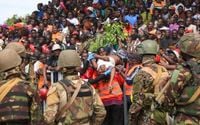Heavy security blanketed the western Kenyan city of Kisumu on Saturday as tens of thousands gathered for the final public viewing of former Prime Minister Raila Odinga, whose death this week triggered an outpouring of grief and, tragically, deadly unrest. The 80-year-old opposition leader, revered for his decades-long fight for democracy, died Wednesday, October 15, 2025, in India from a suspected heart attack. His passing has left much of Kenya, and particularly his Luo tribal heartland, reeling with loss.
Odinga’s coffin, draped in the national flag, arrived by helicopter at Kisumu’s soccer stadium on October 18, 2025, where thousands had camped overnight, hoping for a final glimpse of the man they called “Baba.” Chants of “We are orphans” and “Without Baba, we are dead. We don’t have anywhere to go,” echoed through the crowd, as reported by AFP journalists. The sheer emotion and heat proved overwhelming for some: dozens fainted, and a minor scuffle left several injured, though no major incidents were reported during Saturday’s vigil, according to the Associated Press.
The road to this final farewell has been fraught with tragedy. Since Odinga’s body returned to Kenya on Thursday, October 16, five people have died and more than 170 have been injured in a series of chaotic scenes surrounding public mourning events. On Thursday, police fired live bullets and tear gas at a surging crowd desperate to reach Odinga’s casket, resulting in three fatalities and at least 10 injuries, the AP confirmed. The following day, a stampede broke out shortly after dignitaries departed the state funeral service in Nairobi, killing two and injuring 163—some so severely they required hospital care, according to Doctors Without Borders and the Kenyan Red Cross.
Amid the heartbreak, Odinga’s family and allies have pleaded for calm. His widow, Ida Odinga, urged Kenyans to “mourn peacefully,” reminding them that her husband despised dishonesty and greed. His brother, Oburu Odinga, implored mourners not to provoke security forces: “Raila should not be tear-gassed in death. He has been tear-gassed enough when he was alive. Please let us not cause a situation where he is tear-gassed again,” he said during Friday’s service, as reported by the AP. Their appeals came after scenes of mourners breaching security barriers, climbing stadium structures, and being overcome by emotion and exhaustion.
Odinga’s body lay in state at the Kenyan Parliament on Friday morning, an honor typically reserved only for presidents and former presidents. Thousands queued for hours to pay their respects, a testament to the deep affection and respect he commanded across the nation and beyond. Former U.S. President Barack Obama and Kenyan President William Ruto were among those who publicly lauded Odinga’s legacy. Ruto, who once campaigned for Odinga during the disputed and violent 2007 election before becoming his rival in subsequent races, described him as “a patriot and selfless statesman who helped to steady Kenya.”
“Whenever the nation needed him to rise above (the) self, he always did so unreservedly,” President Ruto said, leading mourners in singing Odinga’s favorite song, Harry Belafonte’s “Jamaica Farewell,” during the Anglican Church service. Ruto also praised Odinga’s pivotal role in shaping some of Kenya’s most consequential laws, noting his 15 years as a legislator and his relentless advocacy for democratic reforms.
Indeed, Odinga’s career was marked by perseverance and sacrifice. Over three decades, he ran for Kenya’s presidency five times, never quite clinching the top job but always remaining a central figure in the country’s political evolution. He was instrumental in steering Kenya toward multiparty democracy, often at great personal risk. As political analyst Herman Manyora told the Associated Press, “You can’t point at a man more willing to sacrifice everything just for the sake of his people.”
The outpouring of grief in the days since his death has underscored Odinga’s profound bond with ordinary Kenyans. His supporters, known for their passion and resilience, have turned out in their thousands at every opportunity. Many, like 20-year-old Don Pelido, expressed a sense of orphanhood and uncertainty about the future without their beloved leader.
Odinga’s funeral events have drawn not just the masses but also Kenya’s political elite and international observers. Dignitaries and family members, including his wife Ida, daughters Winnie and Rosemary, and son Raila Odinga Junior, attended the state funeral service in Nairobi. Winnie, who was with her father in India, led mourners in chanting in the Luo language, recalling how Odinga died “strong, with dignity and pride” after insisting on his morning walk—extending it from his usual two to five rounds around the hospital grounds.
In a departure from tradition for such a prominent figure, Odinga’s family announced that he had requested to be buried quickly—ideally within 72 hours of his death. His final resting place will be at his rural home in Bondo, western Kenya, with the burial scheduled for Sunday, October 19, 2025.
The heavy security presence in Kisumu on Saturday—military officers, regular police, and air surveillance teams—reflected both the authorities’ determination to prevent further tragedy and the immense significance of the occasion. While there was a minor scuffle and several faintings due to the heat and emotion, the day passed without the major violence that had marred earlier events.
The tumultuous scenes of the past week have also reignited debate about crowd control and public mourning in Kenya. The police response—particularly the use of live ammunition and tear gas—has drawn criticism from some quarters, while others have focused on the logistical challenges of managing such vast, emotionally charged gatherings. Odinga’s own history of being tear-gassed during protests was not lost on mourners or his family, lending a painful irony to the events of his final days.
Odinga’s impact on Kenyan politics is difficult to overstate. Even in death, he has brought together a nation often divided by politics and ethnicity, if only in shared grief. His final journey has been marked by both tragedy and extraordinary displays of unity and affection—a reflection of a life spent striving for a better, fairer Kenya.
As the country prepares for his burial in Bondo, many are left to ponder what comes next. For now, though, Kenya pauses to remember a statesman whose legacy, for better or worse, will shape its future for years to come.

